Nanotechnology provides powerful tools for environmental monitoring and cleanup by enabling highly sensitive sensors that detect pollutants in real time and at low concentrations. Nanomaterials improve water purification, trapping or breaking down contaminants more effectively. Nanoparticles also target pollutants directly, aiding in remediation efforts. While these innovations promise faster and more efficient solutions, it’s important to contemplate safety and environmental impact. Keep exploring to uncover how nanotech is transforming pollution control and safeguarding our planet.
Key Takeaways
- Nanomaterials enable highly sensitive, rapid environmental sensors for real-time detection of pollutants like heavy metals and organic compounds.
- Advanced nanosensors facilitate continuous monitoring in various environments, providing instant data and early warning systems.
- Nanotechnology-enhanced filtration systems utilize nanocoatings and nanocomposites to improve removal of contaminants from water and air.
- Nanoparticles such as zero-valent iron are used in remediation to target and break down specific pollutants, including chlorinated organics.
- Safety and environmental concerns require comprehensive risk assessments to balance nanotech benefits with potential toxicity and persistence issues.
The Role of Nanomaterials in Detecting Environmental Pollutants

Nanomaterials have revolutionized the way we detect environmental pollutants by offering high sensitivity and rapid response times. When you use nanomaterial-based sensors, you can identify even trace amounts of contaminants quickly and accurately. These materials have a large surface area relative to their size, which enhances their ability to interact with pollutants. For example, nanoparticles like gold or carbon nanotubes can be functionalized with specific molecules to target pollutants such as heavy metals or organic compounds. As a result, detection becomes more precise and efficient. Additionally, the development of high-performance sensors allows for even more reliable environmental monitoring. Plus, nanomaterials can be integrated into portable devices, making field testing easier. This innovative approach markedly improves early warning systems, helping you respond faster to environmental hazards and better protect ecosystems and public health.
Advanced Nanosensors for Real-Time Monitoring of Contaminants

Advanced nanosensors enable real-time detection of environmental contaminants with unparalleled speed and accuracy, transforming how you monitor pollution levels. These tiny devices can identify specific pollutants at incredibly low concentrations, providing instant data on air, water, or soil quality. You can deploy them in various environments, allowing continuous surveillance without manual sampling. Their high sensitivity stems from nanomaterials that interact directly with target molecules, producing measurable signals. This rapid feedback helps you respond quickly to contamination events, preventing environmental damage. Plus, their portability and ease of integration with digital systems make them ideal for widespread deployment. With advanced nanosensors, you gain detailed, immediate insights into pollution dynamics, enabling more effective and timely environmental management efforts. Incorporating personal development techniques like goal setting and self-reflection can further enhance your ability to implement sustainable environmental practices effectively.
Nanotechnology-Enhanced Water Purification Techniques
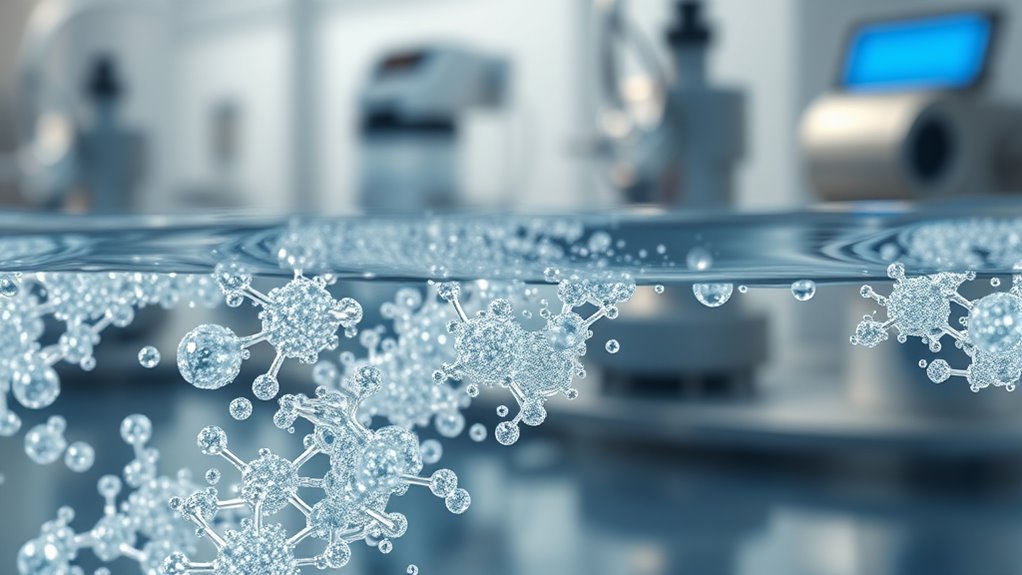
Nanotechnology revolutionizes water purification by improving filtration systems with nanomaterials that can remove contaminants more effectively. You’ll find that nanocoatings enhance antimicrobial properties, making water treatment safer and more reliable. Additionally, nanomaterials boost adsorption efficiency, enabling purification processes to target a wider range of pollutants quickly. This technological advancement is supported by ongoing research into best anime movies, which highlights the importance of innovative storytelling and diverse applications.
Nanomaterials in Filtration
Filtration systems have seen significant improvements through the incorporation of nanomaterials, which enhance their ability to remove contaminants from water. Nanomaterials like nanoparticles, nanofibers, and nanotubes increase the surface area and reactivity of filters, enabling them to trap smaller particles and dissolved pollutants more effectively. For example, silver nanoparticles provide antimicrobial properties, reducing bacterial presence. Similarly, carbon nanotubes improve mechanical strength and filtration efficiency for organic compounds and heavy metals. You’ll notice that these nanomaterials can be integrated into existing filter designs or form the core of new, advanced membranes. Their high surface area-to-volume ratio allows for better pollutant adsorption and physical separation, making filtration processes faster, more effective, and capable of targeting a broader range of contaminants.
Adsorption Efficiency Enhancement
By incorporating nanomaterials into water purification processes, you can substantially boost adsorption efficiency, enabling contaminants to be removed more quickly and thoroughly. Nanomaterials increase surface area and reactivity, which improves adsorption capacity. They can target specific pollutants, such as heavy metals or organic compounds, with high precision. Techniques like functionalized nanoparticles or nanocomposites optimize interactions between contaminants and adsorbents. To illustrate, consider the following methods:
| Method | Nanomaterial Type | Key Benefit |
|---|---|---|
| Surface functionalization | Metal oxide nanoparticles | Enhanced selectivity |
| Nanocomposites | Carbon-based nanomaterials | Increased capacity |
| Magnetic nanoadsorbents | Magnetic nanoparticles | Easier separation |
| Doped nanomaterials | Doped metal oxides | Improved reactivity |
| Layered nanostructures | 2D nanomaterials | Greater surface interaction |
These approaches elevate purification speed and effectiveness, making water safer. Additionally, reusability of nanomaterials can further improve the sustainability and cost-effectiveness of water treatment systems.
Antimicrobial Properties of Nanocoatings
Nanocoatings infused with nanomaterials have revolutionized water purification by providing potent antimicrobial properties. These coatings actively kill or inhibit bacteria, viruses, and other pathogens, making water safer to drink. Nanomaterials like silver, copper, and zinc nanoparticles release ions that target microbial cells, disrupting their membranes and metabolic processes. This prevents biofilm formation and reduces contamination risks. The durability and high surface area of nanocoatings ensure long-lasting antimicrobial effects, even in challenging environments. You can apply these coatings to filtration membranes, pipes, and storage tanks to enhance their protective capabilities. Additionally, selecting names that resonate with the preppy aesthetic can be beneficial when branding or marketing these advanced water purification solutions. As a result, nanocoatings contribute markedly to cleaner water sources, helping communities access safe drinking water and reducing reliance on chemical disinfectants.
Remediation Strategies Using Nanoparticles
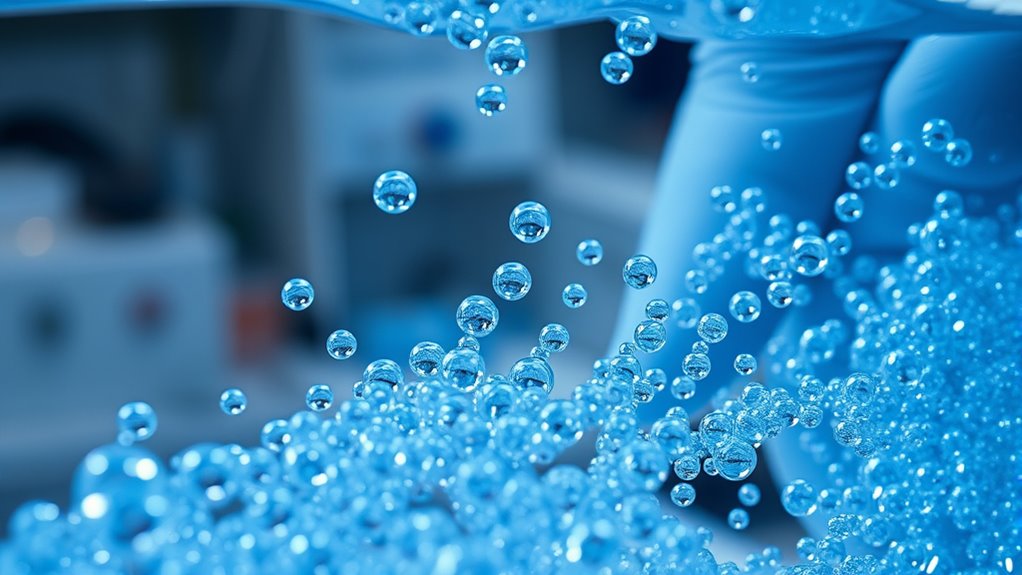
Nanoparticles have emerged as powerful agents in environmental remediation due to their unique physical and chemical properties. Their high surface area and reactivity enable you to target contaminants more effectively than traditional methods. You can use nanoparticles to adsorb heavy metals, break down organic pollutants, or catalyze chemical reactions that detoxify hazardous substances. For instance, zero-valent iron nanoparticles are especially good at reducing chlorinated compounds in groundwater. You can also incorporate nanoparticles into filtration systems or inject them directly into contaminated sites for in-situ treatment. This versatility allows you to customize remediation strategies based on the specific pollutants and environmental conditions. Additionally, understanding well-being tips can enhance your capacity to manage the stresses associated with environmental cleanup projects. By harnessing nanoparticles, you improve cleanup efficiency, reduce treatment time, and minimize the need for extensive excavation or chemical use.
Challenges and Safety Considerations in Nanotechnology Applications
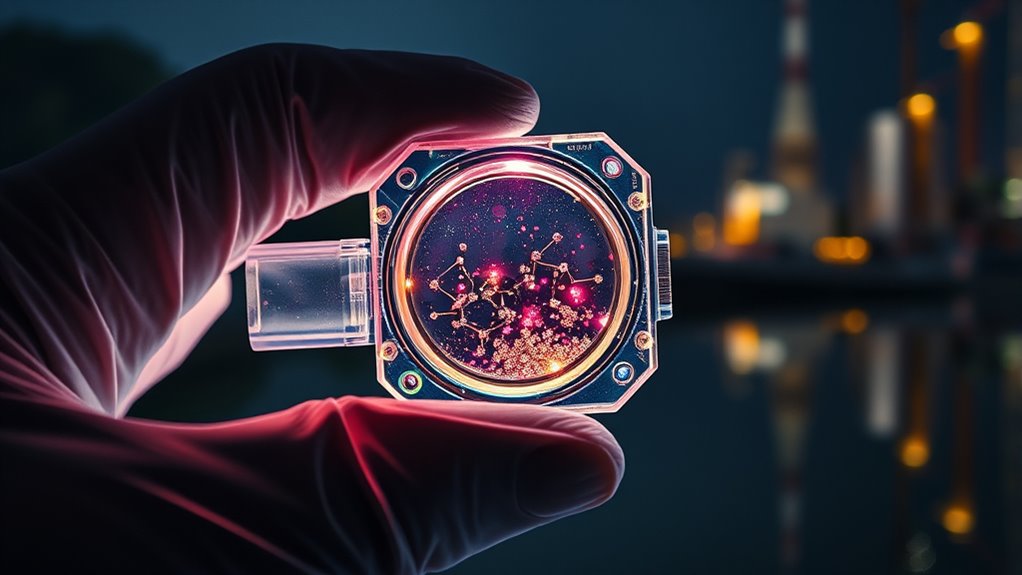
As you explore nanotechnology’s potential, it’s important to consider the risks associated with nanoparticle toxicity and how these particles might persist in the environment. You also need to understand the challenges in developing effective regulations to guarantee safe use. Addressing these safety considerations is vital for responsible innovation and public trust. Additionally, integrating AI safety measures can help monitor and mitigate unforeseen risks associated with nanomaterials.
Nanoparticle Toxicity Risks
Have you ever wondered about the potential risks associated with using nanotechnology for environmental purposes? Nanoparticles can pose toxicity risks if they enter human or ecological systems. Their small size allows them to penetrate cells and tissues, potentially causing oxidative stress, inflammation, or genetic damage. The unpredictability of nanoparticle behavior makes it difficult to fully assess their safety, especially since their interactions with biological systems are complex. If not properly managed, these particles could accumulate in organisms, leading to long-term health effects and environmental contamination. Implementing comprehensive testing protocols and risk assessments are essential to prevent unintended harm. Ensuring safe handling, thorough testing, and risk assessments are essential to prevent unintended harm. As you develop or deploy nanotechnologies, understanding these toxicity risks helps you balance innovation with safety.
Environmental Persistence Concerns
While understanding the toxicity risks of nanotechnology is important, another significant concern is how long these particles persist in the environment. Persistent nanomaterials can accumulate in soil, water, and organisms, leading to long-term ecological impacts. You need to contemplate whether these particles degrade naturally or remain intact, potentially causing unintended harm. Their small size allows them to travel easily, crossing ecological boundaries and entering food chains. If nanomaterials are stable and resistant to breakdown, they may pose risks that are hard to predict or control. This persistence could lead to bioaccumulation, affecting wildlife and human health. Addressing these concerns involves evaluating nanoparticle stability, environmental interactions, and developing strategies to minimize long-lasting residues that threaten ecosystems. Additionally, environmental persistence impacts the overall safety and sustainability of nanotechnology applications.
Regulatory Framework Challenges
Regulatory frameworks for nanotechnology applications face significant challenges due to the unique properties and behaviors of nanomaterials. These materials often exhibit different toxicity, mobility, and environmental interactions compared to bulk counterparts, making traditional regulations inadequate. You might find it difficult to assess risks because nanomaterials can behave unpredictably at the nanoscale. Standard safety testing methods may not account for their specific characteristics, leading to gaps in safety assessments. Additionally, rapid technological advancements outpace existing regulations, creating a lag in oversight. Jurisdictional differences further complicate regulation, as countries develop varied standards and guidelines. As a result, you need clear, adaptable policies that address nanomaterials’ distinct risks while fostering innovation in environmental monitoring and remediation.
Future Directions in Environmental Nanotechnology
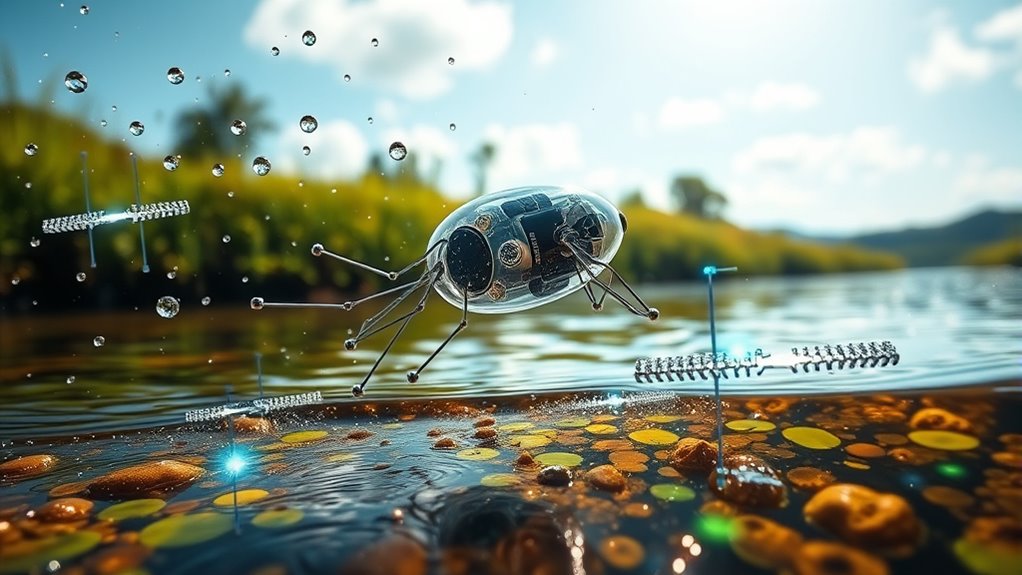
What does the future hold for environmental nanotechnology? You can expect advancements that make nanomaterials more sustainable, efficient, and targeted. Researchers are focusing on designing eco-friendly nanoparticles that minimize environmental impact while maximizing remediation capabilities. Smart nanodevices will likely play a bigger role, enabling real-time monitoring and adaptive responses to pollution. Integration with artificial intelligence and big data will enhance prediction, detection, and cleanup processes. You’ll see increased emphasis on scalable, cost-effective solutions that can be deployed globally, especially in underserved areas. As materials become more specialized, their safety profiles will improve, addressing current concerns. Overall, future directions aim to make nanotechnology an essential tool for cleaner, healthier environments, with innovations aligned with ecological and societal needs.
Case Studies Showcasing Nanotech Successes in Pollution Control
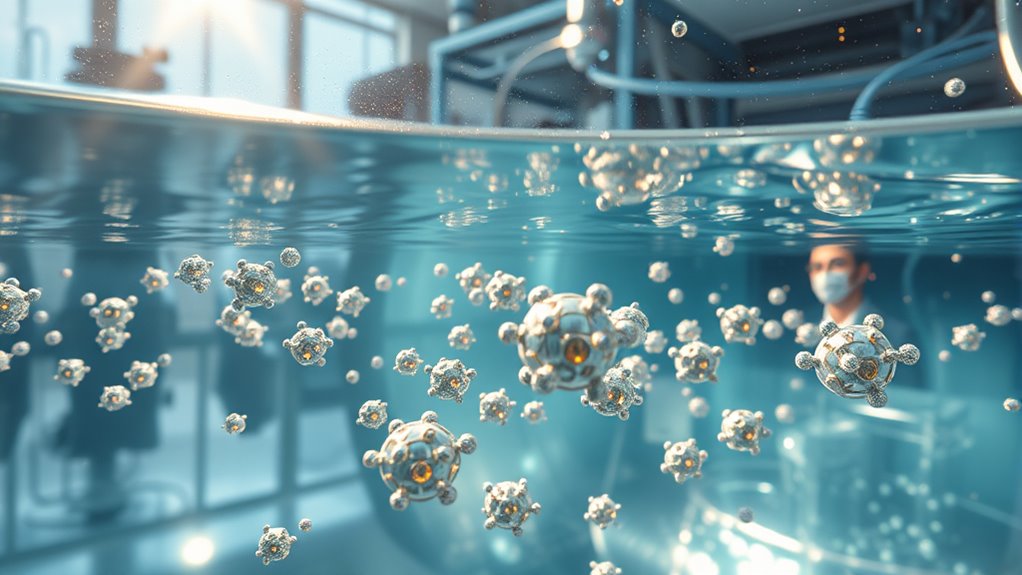
Have nanotechnology breakthroughs truly transformed pollution control efforts? Absolutely. Take the case of nanomaterials used to clean oil spills, where nanosponges absorb hydrocarbons effectively, reducing environmental impact. In water treatment, silver and titanium dioxide nanoparticles now remove bacteria and degrade organic pollutants more efficiently than traditional methods. Another success story involves air purification: nanofilters trap fine particulate matter, improving air quality in urban areas. Additionally, nanotech coatings on industrial equipment prevent corrosion and reduce pollutant emissions. These examples demonstrate how nanotechnology enhances cleanup speed, efficiency, and cost-effectiveness. By implementing these innovations, communities can better protect ecosystems and public health, showcasing nanotech’s tangible benefits in pollution control. These case studies prove that nanotech isn’t just theoretical—it’s actively making a difference today.
Frequently Asked Questions
How Cost-Effective Are Nanotechnology Solutions for Large-Scale Environmental Issues?
Nanotechnology solutions can be quite cost-effective for large-scale environmental issues because they often require less material and energy, leading to lower long-term costs. You can achieve faster cleanup and monitoring, reducing overall expenses. While initial investments might be higher, the efficiency and effectiveness of nanotech applications often save money over time, making them a viable option for addressing widespread environmental challenges economically.
What Regulations Govern the Use of Nanomaterials in Environmental Applications?
Regulations on nanomaterials are like a safety net, ensuring responsible use. You’ll need to follow agencies like the EPA and OSHA, which set guidelines on testing, handling, and disposal. International standards from organizations like the OECD also influence practices. Staying compliant means you must keep up with evolving policies, conduct risk assessments, and document your procedures carefully, ensuring both safety and effectiveness in environmental applications.
How Do Nanomaterials Interact With Non-Target Organisms in Ecosystems?
You might find that nanomaterials can interact with non-target organisms in ecosystems by attaching to cells or being ingested, potentially causing toxicity or disrupting biological processes. These tiny particles can accumulate in plants, animals, or microbes, leading to unforeseen effects. It’s essential to study their behavior carefully, as their small size and reactivity increase the chance of unintended interactions, which could harm ecosystem balance and biodiversity.
Are There Long-Term Environmental Impacts of Deploying Nanotechnology?
Yes, deploying nanotechnology can have long-term environmental impacts. You might encounter issues like nanoparticle accumulation in ecosystems, which could harm plants, animals, and microbes. These particles may persist for years, disrupting natural processes or entering food chains. You should carefully assess potential risks, monitor environmental changes over time, and develop strategies to minimize negative effects to guarantee safe and sustainable use of nanotech in the environment.
What Are the Ethical Considerations Surrounding Nanotechnology in Environmental Management?
You should consider the ethical implications of nanotechnology in environmental management, including potential risks, societal impacts, and issues of consent. You’re responsible for ensuring transparency, prioritizing safety, and addressing environmental justice. You must weigh the benefits against possible harm, promote equitable access, and prevent misuse. By doing so, you help build trust, foster responsible innovation, and protect both ecosystems and communities from unintended consequences.
Conclusion
As you explore nanotechnology’s potential, you can see how it revolutionizes environmental monitoring and cleanup. With advanced sensors and innovative remediation methods, you’re equipped to tackle pollution more effectively. But aren’t we risking unintended consequences by rushing into these new technologies? Embracing nanotech requires careful balance—leveraging its benefits while safeguarding our environment. By staying informed and responsible, you can help shape a cleaner, healthier future powered by innovative nano-solutions.









